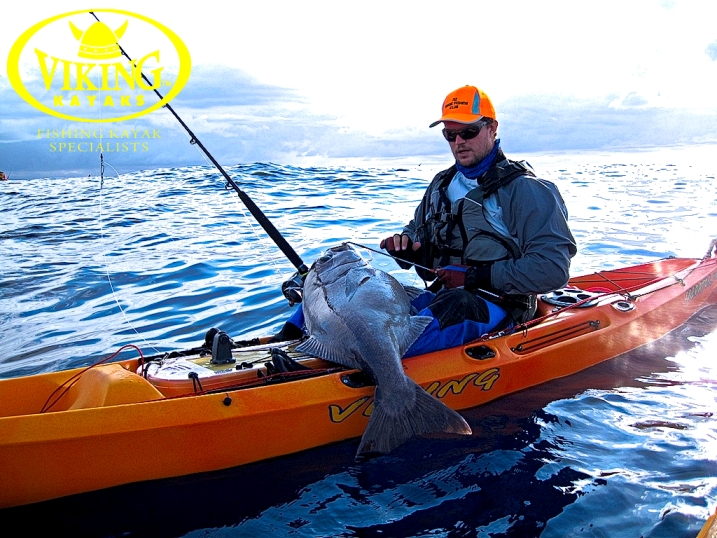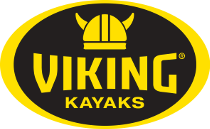Kayak Fishing Expedition Season
11:13PM 26th Sep 14

Bryce with a superb bluenose from a previous White Island mothership trip – new kayaks and new camera systems and a few new tackle tricks will see us out there trying for new PB’s, and also attempting to catch them on paddle from shore missions.
Expedition Season, by Stephen Tapp
The next few months is going to see a hectic schedule trying to fit in a series of kayak competitions and expeditions. In little more than a week we begin with the Top Catch Cove to Cape kayak contest, September will see missions to Lottin Point and Hicks Bay to try for “paddle from shore” bluenose, Labour Weekend will see a mothership trip with Rick Pollock aboard Pursuit, and finally there’s the Viking Coromandel Gold Rush event at the end of November.
The goal throughout is to hopefully improve a couple of PB’s, achieve a first (for me at least) in capturing a bluenose without the use of a mothership, and if the weather will allow to hopefully capture stills and video that will pass on a hint of the high adventure we will hopefully experience. Given this is the primer for what is to come, let’s take a look at what I’m doing differently to make the fishing easier and to help ensure I can bring the stories home with me.
Getting organized
This is going to be a mean schedule, especially since the weather at this time of the year isn’t very forgiving. The key to making it work is being organized enough to have everything ready to go at a moment’s notice. Tackle rigged and ready, paddling kit packed, and the kayak on the roof rack ready to hit the road.
One of the biggest changes for me has been to properly set up my on-board tackle boxes. I know it’s such a simple thing, and there are probably many kayak anglers out there already doing this. I did it to a limited extent but was never serious enough about it to make it work properly. Now I effectively have a series of “modules” that take moments to select and load into the kayaks Tackle-Pod depending on what the goal is for the day:
- Bait Box – this has a range of ledger rigs, live bait rigs, balloons, sabikis, and leader material. It also has the special purpose rigs I use when targeting fish like big trevally. I always have my strayline rigs with me regardless, so these along with swivels and scissors live in pockets in my PFD. The bait box basically contains all my other bait fishing requirements for inshore coastal fishing.
- Jig Box – this contains jigs, spilt ring pliers, assist rigs, and everything else needed for mechanical jigging
- Lure Box – this contains a selection of bibbed and other hard body lures, a few trolling feathers and salt water flies, and a few inchiku / butterfly style lures along with the necessary hardware
- Deep Water Box – this has everything from terakihi rigs, deep water sabiki’s for catching bait, and heavy duty strayling rigs to hapuku and bluenose rigs
In addition to the above I have a small container for a selection of ball sinkers, and a partitioned tackle box with a range of softbait jig heads that can slip in when required. This system makes it possible to change on-board tackle in seconds to accommodate different fishing plans, and makes an incredible difference in two ways. Firstly, it makes it easy to swap between different types of paddling missions to make the most of weather windows up and down both coasts. Secondly, it’s a breeze to change to “Plan-B” if you get to your launch spot and the weather has changed.
This whole concept is easy and inexpensive to set up, but has dramatically improved my flexibility. It has also taken a lot of stress out of deciding what to take for each trip. Finally, it also means I’m not carrying so much tackle on board trying to cover every conceivable scenario. I can decide on the beach, and if needed I can head back to shore and reconfigure in moments.
The new StarPort HD has a bigger footprint and four fastenings for a much more rigid mount on plastic kayaks – perfect for mounting camera booms.
If it’s not on film it never happened
This is one area that’s seen massive change over the last couple of years. The advent of excellent quality wide angle POV cameras has opened whole new worlds for capturing the antics we get up to on our kayaks. Both video and stills with high enough resolution to adorn the pages of this magazine are easily possible, and the old adage of “if it isn’t on film it never happened” is now truer than ever.
Even the excuse of not having anyone else present to act as photographer is no longer valid. Most of these cameras have viewing angles wide enough to make on-board selfies a breeze, all it takes is a little effort in setting up camera positions to capture the best angles.
With new fastening systems it’s now possible to get really creative with camera mounting, finally making it possible to catch some of the action right at the side of the kayak. This will be put to good use during expeditions over the next few months.
One shot that’s been difficult for me in the past has been an angle that properly captures loaded rods and some of the frenetic action as a fish is landed at the side of the kayak. RailBlaza have just released their new StarPort HD, a heavy duty version of their StarPort with a larger footprint and four fastenings – twice as many as the standard StarPort. This removes a lot of flex when fitted to rotationally molded polyethylene and has made it possible to mount cameras in new locations.
The greater rigidity can be enhanced with a backing plate in areas with internal access, but even in areas without a little ingenuity will provide a stable camera mount. In my case the StarPort HD’s are simply fitted with self-tapping screws, and by bracing the camera boom and loading it with a tensioner I now have a means of capturing a new perspective of the battle, and what it takes to land some of the fish aboard.
Flat camera and mobile phone batteries are now a thing of the past, even when on away trips without power. A 12 volt SLA battery and accessory USB charger makes it possible to keep filming anywhere.
More power
One aspect of using one or more POV-style cameras, particularly when away from mains power (fishing remote locations while camping, or aboard motherships where there’s often limited means to charge batteries) is keeping them charged. The same applies to other important equipment such as mobile phones.
There are a variety of compact sized USB power packs available, but I’ve found most of these too small to really be useful (one or maybe two full charges for the camera and battery backpack is often all they’ll deliver). The solution I’ve found for those times when multiple charges for each of two cameras and a cell phone has been to utilize one of my larger sounder 12 volt SLA batteries and an inexpensive 4-port USB charger designed for automotive accessory sockets.
One of my old 18 amp/hour batteries that had been retired when I converted my kayak to much lighter lithium iron (LiFePO4) technology has been brought back into service. This battery is capable of charging the GoPro wireless remotes, camera battery, and accessory battery backpack four times, as well as my mobile phone at least once before needing to be charged. For those needing more capacity a solar panel could be added to help maintain the main battery’s charge for as long as possible.
Managing all the recorded video and images is as straight forward as carrying additional data cards, then getting to relive the trip when editing everything back at home.
Regular gear inspections are critical to make sure everything is seaworthy for your next kayak session. It would be tragic to waste all the time and effort getting to this point before discovering something that keeps you off the water – remind each other to do a “pre-flight check”
Final checks and safety kit
One critical step when gearing up for a hectic paddling and fishing schedule is to maintain a regular safety check. This means going over your kayak before and after every trip with an eye to detail looking for anything that’s loose or dislodged, that may not perform as expected, and most critically has the potential to create leaks.
When washing the kayak at the end of a trip I like to use the hose and spray gun to focus my attention. Everywhere the water hits gets a detailed look. Fittings are then grabbed and wiggled to see if there’s excessive play, and any shackles or quick links are checked they’re tight. I finish off by squirting the hose at hatches before checking inside to see if they’ve leaked. Doing all this at the end of a session means that if I do find a problem there’s time to remedy it before the next trip.
Equally critical is doing the “pre-flight check” before you launch – I’ve witnessed many kayak anglers scrambling to get on the water fail to do this. A classic example is not realizing one of the rudder cable shackles has vibrated loose on the rough road trip getting there. Again, I’ve seen this happen, and the result was a highly embarrassing broach as the loose shackle finally let go right in the middle of the surf zone!








